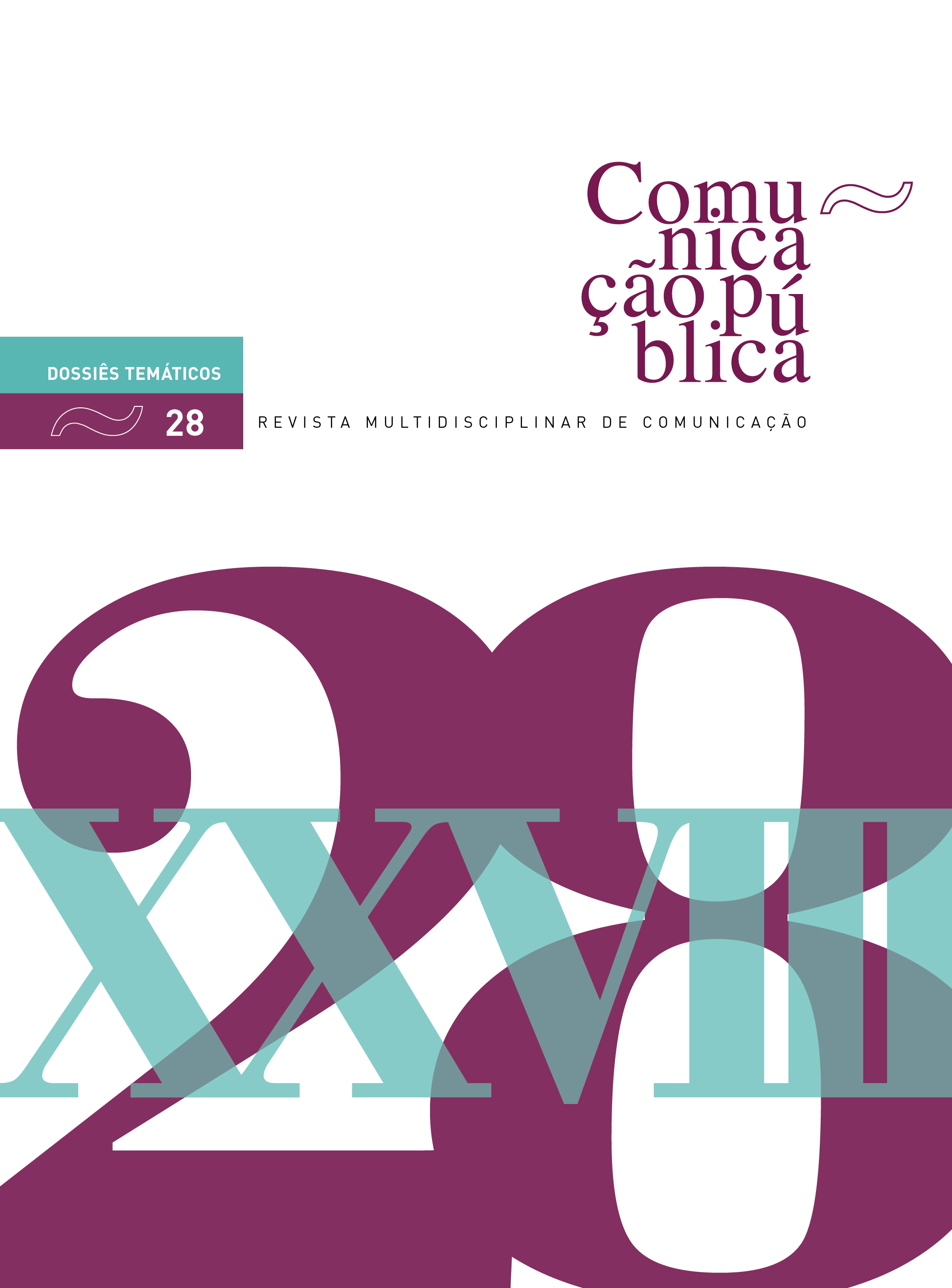Destination Branding of Porto
A Case Study
DOI:
https://doi.org/10.4000/cp.7623Keywords:
integrated marketing communication, destination branding, tourism, Porto, omnichannel communicationAbstract
This article examines how the communication and tourism promotion of the destination Porto (Portugal) are promoted and communicated, using techniques of brand destination, which means the creation and management of a city's brand in order to make it attractive to tourists. The communicative efforts of Porto’s DMO (Destination Marketing Organization) were analyzed in order to understand what kind of messages are sent, their content and through which media these messages are published. The conclusion was that the city of Porto is promoted by three DMOs that work together to portray a favorable image of the destination, targeting each segment of the audience with specific content and media.
Downloads
References
Aires, E. (2017). Porto. Manual de identidade. Disponível em: http://www.cm- porto.pt/assets/misc/documentos/Logos/01_Manual_14_digital_2017.pdf (Consultado 05 junho 2019).
Associação de Turismo do Porto e Norte (2013a). Porto Convention Bureau. Disponível em: http://br.visitportoandnorth.travel/Porto-Convention/Sobre-nos (Consultado 05 junho 2019).
Associação de Turismo do Porto e Norte (2013b). Sobre a Associação de Turismo do Porto. Disponível em: http://br.visitportoandnorth.travel/ATP/Sobre-a-Associacao-de-Turismo-do-Porto (Consultado 05 junho 2019).
Bryman, A. (2012). Social research methods. New York: Oxford University Press.
Câmara Municipal do Porto (s.d.). Identidade gráfica. Disponível em: http://www.cm-porto.pt/cidade/porto-incomparavel-incontornavel-ponto (Consultado 05 junho 2019).
Câmara Municipal do Porto. (s.d.). Porto. Disponível em: http://www.cm-porto.pt/ (Consultado 05 junho 2019).
Câmara Municipal do Porto (s.d.). VisitPorto. Disponível em: http://www.visitporto.travel/ Visitar/Paginas/Default.aspx (Consultado 05 junho 2019).
Cao, L., Li, L. (2015). The impact of cross-channel integration on retailers’ sales growth. Journal of Retailing, 91(2), 198-216. DOI : 10.1016/j.jretai.2014.12.005
Cooper, C., & Hall, C. M. (2008). Contemporary tourism: An international approach. Oxford: Elsevier.
Creswell, J. W. (2014). Research design: Qualitative, quantitative, and mixed methods approaches (4ª ed.). Thousand Oaks: SAGE Publications.
Grigorescu, A., & Lupu, M. M. (2015). Integrated communication as strategic communication. Review of International Comparative Management, 16(4), 479-490.
Hankinson, G. (2004). Relational network brands: Towards a conceptual model of place brands. Journal of Vacation Marketing, 10(2), 109-121. DOI : 10.1177/135676670401000202
Hankinson, G. (2007). The management of destination brands: Five guiding principles based on recent developments in corporate branding theory. Journal of Brand Management, 14(3), 240-254. DOI : 10.1057/palgrave.bm.2550065
Hine, C. (2005). Virtual methods: Issues in social research on the internet. Oxford: Berg.
Hine, C. (2015). Ethnography for the Internet: Embedded, embodied and everyday. London: Bloomsbury.
Instituto Nacional de Estatística (INE, 2018). Estatísticas do turismo 2017. Lisboa: Instituto Nacional de Estatística.
Kotler, P., Bowen, J. T., Makens, J. C., & Baloglu, S. (2017). Marketing for hospitality and tourism (7ª ed.). Harlow: Pearson Education.
Kotler, P., Haider, D. H., & Rein, I. (1994). Marketing público: Como atrair investimentos, empresas e turismo para cidades, regiões, estados e países. São Paulo: Makron Books.
Marujo, M. N. (2008). Turismo e comunicação. Castelo Branco: RVJ Editores.
Medlik, S. (2003). Dictionary of travel, tourism and hospitality (3ª ed.). Oxford: Butterworth-Heinemann. DOI : 10.4324/9780080521862
Moilanen, T., & Rainisto, S. (2009). How to brand nations, cities and destinations: A planning book for place branding. London: Palgrave Macmillan.
Morgan, N., Pritchard, A., & Pride, R. (2011). Destination brands: Managing place reputation (3ª ed.). New York: Routledge/Taylor & Francis.
Neslin, S., Grewal, D., Leghorn, R., Shankar, V., Teerling, M., Thomas, J., & Verhoef, P. (2006). Challenges and opportunities in multichannel customer management. Journal of Service Research, 9(2), 95-112. DOI : 10.1177/1094670506293559
Percy, L. (2008). Strategic integrated marketing communication: Theory and practice. Burlington: Butterworth-Heinemann.
Portal de Turismo do Município do Porto (s.d.). Visit Porto. Disponível em: http://www.visitporto.travel/Visitar/Paginas/Default.aspx (Consultado 05 junho 2019).
Sebastião, S. P. (2009). Comunicação estratégica: As relações públicas. Lisboa: Instituto Superior de Ciências Sociais e Políticas.
Sebastião, S. P. (2015). Fundamentos de comunicação integrada organizacional e de marketing. Lisboa: Instituto Superior de Ciências Sociais e Políticas.
Tocquer, G., & Zins, M. (1999). Marketing do turismo. Lisboa: Instituto Piaget.
Turismo do Porto e Norte de Portugal (2015). Estratégia de marketing turístico do Porto e Norte de Portugal. Disponível em: http://www.portoenorte.pt/fotos/gca/plano_estrategico_10327505915894b4d3a978b.pdf (Consultado 05 junho 2019).
Turismo do Porto e Norte de Portugal (2019). Apresentação institucional. Disponível em: http://www.portoenorte.pt/pt/porto-e-norte/ (Consultado 05 junho 2019).
Vaz, G. N. (2001). Marketing turístico: Receptivo e emissivo. São Paulo: Pioneira Thomson Learning.
Verhoef, P., Kannan, P., & Inman, J. (2015). From multi-channel retailing to omni-channel retailing: Introduction to the special issue on multi-channel retailing. Journal of Retailing, 91(2), 174-181.
Downloads
Published
Issue
Section
License
Copyright (c) 2020 Direitos do Autor (c) 2020

This work is licensed under a Creative Commons Attribution-NonCommercial 4.0 International License.
Os conteúdos da Comunicação Pública estão licenciados com uma licença Creative Commons - Atribuição-NãoComercial 4.0 Internacional.


